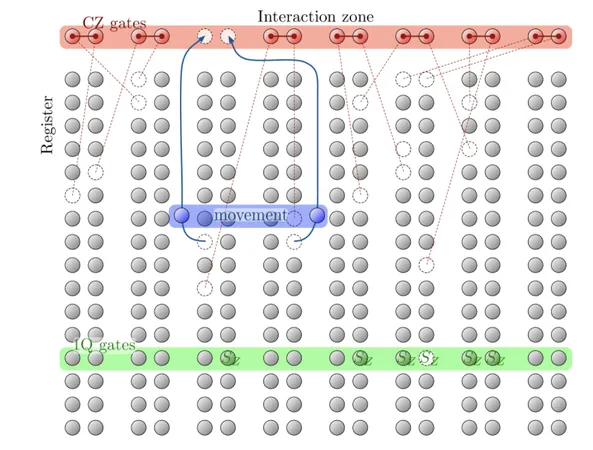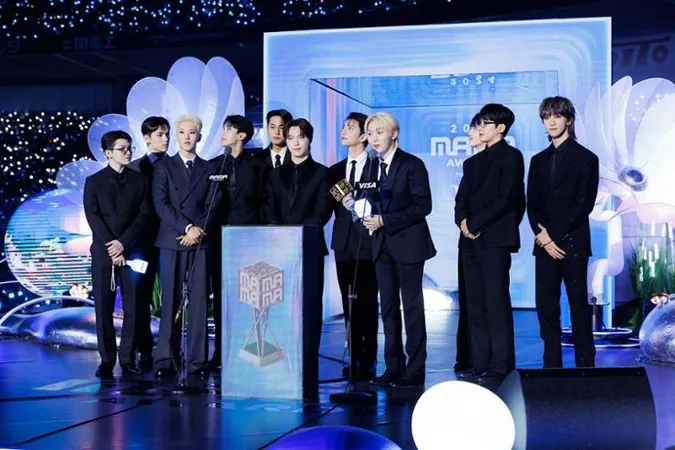
Unveiling the Breakthrough: Microsoft and Atom Computing's Leap into Logical Qubits
2024-11-23
Author: Mei
Unveiling the Breakthrough: Microsoft and Atom Computing's Leap into Logical Qubits
In a significant advancement for quantum computing, Microsoft and Atom Computing have unveiled their remarkable progress in transforming physical qubits into logical qubits using a sophisticated neutral atom quantum processor. This innovation demonstrates enhanced error correction techniques and sets the stage for more powerful computational capabilities.
The study, focusing on ytterbium atoms arranged in a programmable grid, has successfully entangled 24 logical qubits and performed computations on a total of 28 logical qubits. This impressive feat not only reduces error rates but also highlights the power of advanced error-correction methodologies.
This collaborative effort between Microsoft Azure Quantum and Atom Computing signifies a potential turning point in quantum technology. It paves the way for practical quantum computing applications that could soon exceed the capabilities of classical computers in specific tasks. The findings have gained significant attention, particularly because they represent the largest number of logical qubits entangled to date in experiments conducted by the scientific community.
The researchers documented their findings in a preprint posted on ArXiv, outlining their methods for creating and manipulating these logical qubits using a 256-qubit quantum processor. Their work outlines not only the creation of logical qubits but also the mechanisms for detecting and correcting errors in real time— a crucial step for developing fault-tolerant quantum systems.
The Quantum Leap: Understanding Physical vs. Logical Qubits
To truly appreciate this breakthrough, one must grasp the distinction between physical and logical qubits. Physical qubits serve as the basic building blocks of quantum processors, yet they are often plagued by errors from environmental influences and hardware imperfections. This makes scaling quantum computation a complex challenge.
In contrast, logical qubits enhance reliability by spreading information across multiple physical qubits using error-correcting codes. This redundancy allows for more robust error detection and correction. Think of physical qubits as individual bulbs in a chandelier; they may flicker or fail, but together they provide consistent light, representing a stable logical qubit.
Exploring the Research Methods
The research utilized a neutral atom quantum processor to implement logical qubits with superior error-correcting codes. By employing ytterbium atoms, which are identified for their ability to provide high-fidelity operations, the researchers achieved strong error correction capabilities. The platform's major advantage is its scalability: the laser-manipulated atoms can be moved to facilitate all-to-all connectivity, which is essential for complex quantum operations.
The team employed two main error-correcting codes: the [[4,2,2]] code and the [[9,1,3]] Bacon-Shor code. The former allowed for the entanglement of 24 logical qubits into a "cat" state, while the latter offered a sophisticated method for correcting both qubit loss and logical errors—charting a path toward efficient quantum error correction.
Highlighting the Bernstein-Vazirani Algorithm
Among the study's notable accomplishments was the successfully implemented Bernstein-Vazirani algorithm, known for its prowess in uncovering hidden binary strings with minimal quantum queries. This algorithm's efficiency illustrates the potential for quantum systems to tackle specific problems far more effectively than classical algorithms.
Moreover, the introduction of a qubit virtualization system allowed the researchers to integrate real-time error correction during computations, enhancing the overall reliability of their quantum operations—a monumental step towards scaling quantum technology.
Challenges and Future Considerations
Yet, as with all groundbreaking research, challenges remain. The error-correcting codes used in the study have limitations, particularly in their distance capabilities, which restrict their error-correcting range. Additionally, atom movement could introduce new types of errors, necessitating further refinement in error-correction techniques and precision in laser controls.
To improve, researchers are considering scaling to thousands of qubits to implement higher-distance codes capable of resolving a broader array of errors. Implementing mid-circuit measurement and reinitialization techniques may further enhance the depth of computations, allowing for more profound calculations and insights.
The Broader Picture for Quantum Computing
Despite the road ahead, experts recognize that the collaboration between Microsoft and Atom Computing is a pivotal move toward practical quantum computing solutions. The shift from physical to logical qubits signifies a crucial advance in the field, leading us to a future where quantum computing can resolve problems faster and more accurately than traditional computers.
Notably, the adaptability of neutral atom processors positions them as formidable competitors in the quantum computing landscape, alongside superconducting and trapped-ion processors. This study reinforces Microsoft’s commitment as a key player in the quantum ecosystem, where they leverage their software and platform expertise to drive innovations that will benefit numerous industries.
Stay tuned for more breakthroughs as we continue to follow Microsoft and Atom Computing's pioneering journey into the world of quantum technologies!

 Brasil (PT)
Brasil (PT)
 Canada (EN)
Canada (EN)
 Chile (ES)
Chile (ES)
 España (ES)
España (ES)
 France (FR)
France (FR)
 Hong Kong (EN)
Hong Kong (EN)
 Italia (IT)
Italia (IT)
 日本 (JA)
日本 (JA)
 Magyarország (HU)
Magyarország (HU)
 Norge (NO)
Norge (NO)
 Polska (PL)
Polska (PL)
 Schweiz (DE)
Schweiz (DE)
 Singapore (EN)
Singapore (EN)
 Sverige (SV)
Sverige (SV)
 Suomi (FI)
Suomi (FI)
 Türkiye (TR)
Türkiye (TR)